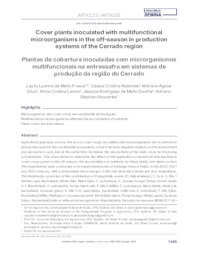Plantas de cobertura inoculadas com microrganismos multifuncionais na entressafra em sistemas de produção da região do Cerrado.
Plantas de cobertura inoculadas com microrganismos multifuncionais na entressafra em sistemas de produção da região do Cerrado.
Autoria: FRASCA, L. L. de M.; REZENDE, C. C.; SILVA, M. A.; LANNA, A. C.; DUARTE, J. R. de M.; NASCENTE, A. S.
Resumo: Agricultural practices such as the use of cover crops inoculated with microorganisms aim to transform productive systems into sustainable ecosystems, since it reduces negative impacts on the environment and production costs and at the same time, increases the productivity of the main crops by improving soil attributes. This study aimed to determine the effect of the application of beneficial rhizobacteria in cover crops grown in the off-season, the accumulation of nutrients by these plants and weed control. The experiments were conducted in an experimental area of Embrapa Arroz e Feijão, in the 2020, 2021 and 2022 seasons, with a randomized block design, in the 2x8 factorial scheme and four replications. The treatments consisted of the combination of 8 vegetable covers ((1. fallow/weeds), 2. Corn, 3. Mix 1 (White Lupin, Buckwheat, White Oats, Black Oats, C. ochroleuca, C. Juncea, Forage Turnip, Coram Cane); 4. 2 (Buckwheat, C. spectabiliis, turnip, black oat); 5. Mix 3 (Millet, C. ochroleuca, black aveite, white oat, buckwheat, Coracan grass); 6. Mix 4 (C. spectabilis, buckwheat, millet and C. breviflora); 7. Mix (Oats, Buckwheat, Millet, Piatã and C. Ocholeuca); and 8. Mix 6 (Oats black, Turnip Forage, White Lupine, Coracan Grass, Buckwheat)) with or without microorganisms (rhizobacteria Serratia marcencens (BRM 32114) + Bacillus sp. (BRM 63573)). The evaluations consisted of the content of nutrients and dry biomass of the aerial part, using the LSD statistical test (p <0.05). Vegetable toppings, especially corn, mix 4 and mix 5, treated with beneficial rhizobacteria increased the amount of phytomass at 60 days after planting, accumulation of macronutrients N, P, K, Ca and Mg and micronutrients Cu, Fe and Mn compared to the fallow treatment. Higher S content was found in the straws of mix 2 and mix 4 and Zn in corn straws, mix 4 and mix 5, regardless of microbial treatment. In addition, plant covers provided reductions in weed incidence. Therefore, plant cover and multifunctional microorganisms stand out as sustainable technologies, since the improvement of nutritional conditions and the amount of dry biomass of cover crops can directly reflect the availability of nutrients for the successor crop and greater protection and organic matter content for the soil.
Ano de publicação: 2023
Tipo de publicação: Artigo de periódico
Unidade: Embrapa Arroz e Feijão
Observações
1 - Por padrão são exibidas publicações dos últimos 20 anos. Para encontrar publicações mais antigas, configure o filtro ano de publicação, colocando o ano a partir do qual você deseja encontrar publicações. O filtro está na coluna da esquerda na busca acima.
2 - Para ler algumas publicações da Embrapa (apenas as que estão em formato ePub), é necessário ter, no celular ou computador, um desses softwares gratuitos. Sistemas Android: Google Play Livros; IOS: iBooks; Windows e Linux: software Calibre.
Acesse outras publicações
Acesse a Base de Dados da Pesquisa Agropecuária (BDPA) para consultar o acervo completo das bibliotecas da Embrapa.

